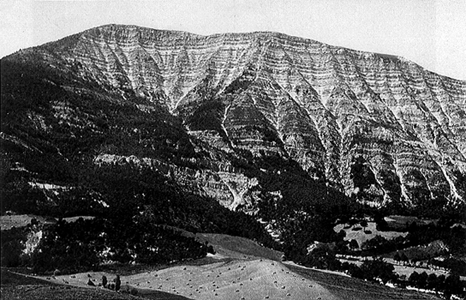
Plane-parallel bedding: panoramic view
Plate 1

Plane-parallel bedding: panoramic view
Plate 1
Before reviewing the various types of sedimentary structures, beds and bedding are introduced as they show up at various scales, both on the Earth's surface (outcrops) and subsurface (instrumental records of acoustic waves, or seismic sections).
The term scale in rock outcrops means two things: the size of the exposed section, and the distance from which it is observed. The example shown here is the side of a mountain (Mt. Carpegna in the Apennines, Italy) and represents a large-scale outcrop, indeed one of the largest possible. Several hundred meters of superposed, parallel strata are visible in the picture, and many of them can be traced laterally for more than 1 km (we say they are continuous within the outcrop limits). The style of stratification is thus clearly expressed, whereas the resolution of the image is not sufficient to tell whether the lines you see, which represent the intersection of bedding planes with the topographic surface, mark individual beds or bundles of beds (bed sets ): geologists can speak of levels or horizons. This problem of resolution is the same as you have in seismic sections (see plate 2), which means that the scale is comparable. Although even a very large outcrop covers only a part of the area of a subsurface section, it gives you an idea of what would appear if you could dig a trench with a gigantic shovel in the fill of a sedimentary basin.
The principles of original horizontality and of superposition, mentioned in the introduction, are well illustrated by this picture. The pile of strata grew regularly, one bed after the other, in the most classical way you can imagine sedimentation to occur. There are, anyway, other growth models for bedding and sedimentary bodies: this one is identified as vertical accretion, aggradation, or, more colloquially, layer-cake.
The formation to which this outcrop belongs is named after another locality of the Apennines (Monte Morello, near Florence); this means that this section is not the type section, which serves to define, according to stratigraphic rules, a lithostratigraphic unit such as a formation. In Alpine chains, geologists still use also names for categories of formations, e.g., flysch and molasse. These terms refer to assumed tectonic and sedimentary conditions of deposition in different development stages of basins associated with fold-thrust belts (orogenic basins ). The M. Morello Formation is a "flysch" of Paleocene age, made mostly of carbonate turbidites that filled a subsiding abyssal plain and were later detached from their oceanic substratum by tectonic compressions that built the Apennines chain.